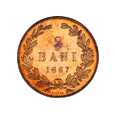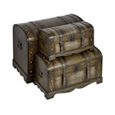ORDERS AND DECORATIONS FROM WORLD WAR I
Romania’s participation in World War I meant, in the first place, human and material losses, but it also meant achieving the Great Unification at the end of the war. In terms of accolades, the period between 1916 and 1918 led to the emergence of new decorations that were adapted to the conditions imposed by the war. Thus, three honors meant to repay the courage in battle were established – the military order Mihai Viteazul in 1916, merits in the sanitary domain – the Crucea Regina Maria order in 1917 and the war participation – the commemorative cross of the war of 1916-1918 in 1918.
The “Mihai Viteazul” national military order
It was established through the Royal Decree no. 2968/ the 26th of September 1916. It was granted exclusively to the officers, for exceptional warfare deeds, through which they distinguished themselves in front of the enemy. It had three classes and the shape of a trefoil cross, made of golden metal, enameled in blue. The dimensions were: 60mm for the first and second class, while the third class one had a dimension of 40 mm. The first class one had the shape of a broche (plaque), the second class one was worn around the neck, and the third class one was worn on the left side of the chest.
On the center of the obverse, there was the crowned cipher of King Ferdinand I, and on the reverse, the year 1916. The ribbon was burgundy and had golden borders; it was attached to the cross through a crown for the first and second classes and through a ring for the third class.
Although there were drawings of the Order made by King Ferdinand himself, initially, neither the pattern, nor the method of granting or wearing it was firmly established, those being settled through usage along the years. In 1927, shortly before his death, King Ferdinand promulgated a document stating that the Knights of this order were to receive some material rights: the allotment of 25 hectares (61.77 acres) of arable land, 500 square meters destined for the building of a home and free transport on the CFR (Romanian railroad system) and SMR (Express transport).
In 1936, King Carol II established a special uniform, a white mantle made of wool fabric and a fur cap, similar to the one worn by the Ruler Mihai Viteazul. The Knights of the Order were wearing it on official occasions, when the officers had to wear the ceremonial attire – all the national and patriotic celebrations. The white mantle had pieces of cloth in the color of the Order’s ribbon sewn on the collar. It was falling down in folds up to 25 cm above the ground, its edges being lined with burgundy silk that was 30 cm wide; a cross of the Order made of blue baize embroidered with a gold thread and sewn on the left side of the chest was mandatory.
The cap was made out of white lamb fur and was worn only by the officers who were in reserve or were about to go in reserve and who, beneath the mantle, were wearing a tailcoat, a black suit or a folk costume. The active officers were wearing the corresponding ceremonial cap based on the army to which they belonged.
Not until the 6th of November 1940, was the first set of rules of the order created, and through the Royal Decree no. 2787, starting with the 8th of October 1941 the form of the 1916 cross was slightly changed; the new model was awarded for the deeds of bravery on the Eastern Front. The obverse had the crowned cipher of King Ferdinand in the center, and on the lower arm of the cross, the year 1916. On the reverse, in the center, the Cipher of King Mihai I can be found and on the lower side, the year 1941 is engraved.
In 1944 another change took place: through the High Royal Decree no.1935/ the 18th of October, the Mihai Viteazul military Order with spades was established, having in the center of the obverse the Crowned Cipher of King Mihai I, whereas, on the reverse, also in the center, the year 1944 was engraved. This model was meant to replace the one from 1941, in order to distinguish the new and old allies (type 1941 – the Germans that received the Order while Romania was part of the Axis and type 1944 – the new allies).
The miniatures were typologically identical with the third class of the Order, but the dimensions were much smaller, approximately 15mm.
The aiguillette was created in 1931, as a symbol of the warfare deeds of the units decorated with this Order. It was worn by officers, noncommissioned officers and the troop, while they were active in a unit decorated with the Mihai Viteazul Order, being a part of the unit’s uniform.
The order also had a flag; it had the shape and sizes of the Cavalry banner. It was granted along with the Order’s insignias to mixed division and brigades, cited three times through the Order of the day in the army, for exceptional warfare deeds carried out on the battlefield. The color of the flag was the same as the Order’s ribbon, bordered by a strip of gold thread and fringes that also had the color of the Order’s ribbon. In the middle, the Order’s cross, the cipher of King Ferdinand I and the year 1916 were embroidered with a blue thread. On the other side, the Cipher of the Sovereign who granted the Order and the year when the event for which it was granted took place, were embroidered. The standard’s finial had the same length as the cavalry one, bearing a griffon at the top and, underneath it, a rectangle which on one side had the name of the unit, and on the other, the motto HONOR AND HOMELAND. Under the rectangle, there was a silver bracelet engraved with the name of the town where the battles for which the Order was granted took place. The banner was carried by a guard of honor to all the solemnities attended by the decorated unit. The regiments were receiving this high Order during a set of special festivities, the flag being decorated by the King in office.
During World War I, honors were granted to the foreign officers from France, Russia, Italy, England, Serbia, Japan, and the United States of America. As far as these officers were concerned, the legal procedure regarding the rank advancement was only partly complied with. Most of the French officers who received the Order were part of the French Military Mission, and most of the Russians were commanders of large units and subunits that fought in cooperation with the Romanian army. The “Mihai Viteazul” order was granted to one foreign regiment only, the 57th Polish Infantry regiment, which was decorated by King Carol II, on the occasion of his visit to Poland, in 1937, when this unit received, in an honorific manner, the name and command of the Romanian sovereign.
After 1947, many of the heroes who were decorated before 1944 were persecuted, discriminated, investigated, put through trial and many of them were sentenced to many years of prison.
The order was reestablished in 2003, and from the old rights, only the one to keep the uniform was kept.
The pieces on display are the following: 320536 (third class, model 1916, AE gilt + enamel, 12.37 g), 75108 (first class, model 1916, AE gilt + enamel, 27.5 g), 236271 (third class, model 1941, AE gilt + enamel), 102164 (second class, model 1941, AE gilt + enamel, 33.64 g), 29108 (second class, model 1944, AE gilt + enamel 41.34 g), 320538 (first class, model 1944, AE gilt + enamel, 32.86 g), 320535 (mini decoration, AE gilt + enamel, 1.86 g), 75460 (patent for the third class granted to the 70th Infantry Regiment, in 1918).
The “ Cross of Queen Marie” Order
It was created through a Royal Decree, on the 15th of March 1917. It was granted to the civilians and militaries who distinguished themselves in the sanitary service, during World War I, as well as in World War II, or during peace times, to the individuals who distinguished themselves in the activity of patient caring during epidemics. The order had three classes.
The badge had the shape of a stylized German cross – a motif chosen by the Queen as a personal cipher, essentially being an old symbol of fertility and rebirth.
For the first class, the cross was enameled in white. On the obverse, in the center, there was a red cross, and on the reverse there was the crowned monogram of Queen Marie. For the other two classes, which were made of copper and gilded copper, on the obverse there was the monogram of Queen Marie, and on the reverse, the year 1917. The ribbon was orange.
The first class one was worn around the neck. The Order had an unlimited number of members and remained unchanged until 1938, when the orange ribbon received a stripe made with gold thread on its edges. This Order, along the “Meritul Sanitar” Cross – created in 1913 – had constituted, until 1948, the specific honors granted to the medical personnel.
The pieces on display are the following: 148929 (third class, model 1917, GE), 102146 (second class, model 1938, AE gilded), 325042 (first class, model 1938, AR gilded + enameled, 19.82 g), 176567 (mini decoration, AR gilded, 1.82 g).
The commemorative cross of the War from 1916 -1918
This decoration was inspired by the similar honors from France and Belgium. Through the High Royal Decree no. 1744 from the 8th of July 1918 this commemorative Cross was created, to reward the militaries and civilians who took part in the Great War. The cross had arrow-shaped points, it was made of a gray-brown metal, with the dimensions of 40/60 mm. On the obverse, in the center, there was the crowned Cipher of King Ferdinand I, and on the reverse, the years 1916/1918 were engraved. The ribbon was dark green, with four dark blue stripes.
On the ribbon, metal strips bearing the name of the towns or the regions where important battles took place were attached transversally. Initially there were 11 strips: ARDEAL, CERNA, JIU, CARPAŢI, OITUZ, BUCUREŞTI, TURTUCAIA, DOBROGEA, MĂRĂŞTI, MĂRĂŞEŞTI and TG. OCNA. After 1918 more strips were added: DUNĂREA, 1918, 1919, SIBERIA, ITALIA and TRADIŢIE. The militaries who took part in the campaign in 1919 in Hungary received the Cross with modified years on the back side, 1916-1919. In 1927 the “ITALIA” strip was added, for the officers and the inferior ranks from the Romanian Legion from Italy and the “SIBERIA” strip for those who fought in that area.
The pieces on display are the following: 336938 (1916/1918, AE, 12.15 g), 126545 (1916/1919, AE, 15.2 g, 2 strips), 52592 (mini decoration, 1916/1919, AE), 319568 (5 strips), 319569 (6 strips), 325857 (4 strips), 86883 (Cross Certificate granted to Colette Plagino, the head of the “Queen Marie” nurses team number 6, in 1926), 87976 (Cross Certificate granted to the Division General Istrate Ioan, in 1919).


















